Ресторан Blue Elephant — королевская тайская кухня
Тайская кухня — настоящий подарок для гурмана, а Пхукет официально провозглашен Городом Гастрономии под эгидой ЮНЕСКО. Если вы хотите попробовать блюда, приготовленные в соответствии со всеми традиционными канонами Королевства, отправляйтесь в старый город, где расположен известный ресторан Блю Элефант. Кулинарный оазис вдали от оживлённых пляжей, в особняке с вековой историей на улице Краби, можно смело включить в список лучших ресторанов Пхукета. Гид Мишлен включил ресторан в свой список, присудив награду The Plate Michelin.
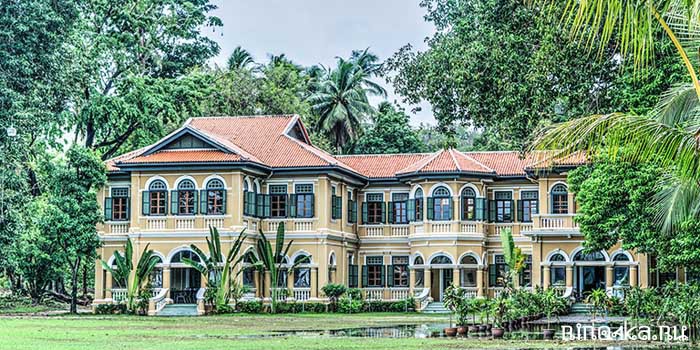
История империи Blue Elephant началась ещё в 1980 году в Брюсселе. Тогда жительница Таиланда и прекрасный шеф-повар Нурор Сомани Степпе со своим бельгийским мужем открыла первый ресторан, а в наше время их уже 8 по всему миру. Филиал на Пхукете расположился в бывшем доме губернатора, построенном в 1903 году. Здание полностью отреставрировано и представляет собой идеальный образец китайско-португальского стиля архитектуры.

Название переводится как «Синий слон» и дано ресторану не случайно. Синий цвет на государственном флаге Таиланда означает королевскую семью, а слон является почитаемым животным. Таким образом в меню пересекаются древние королевские и семейные тайские рецепты. При дворе обычно ели блюда из лучших ингредиентов. Для королевской кухни используются отборные креветки, филе курицы, рыбы, а сочетание нежных ароматов уникально: не слишком остро, не слишком сладко и не слишком солено.
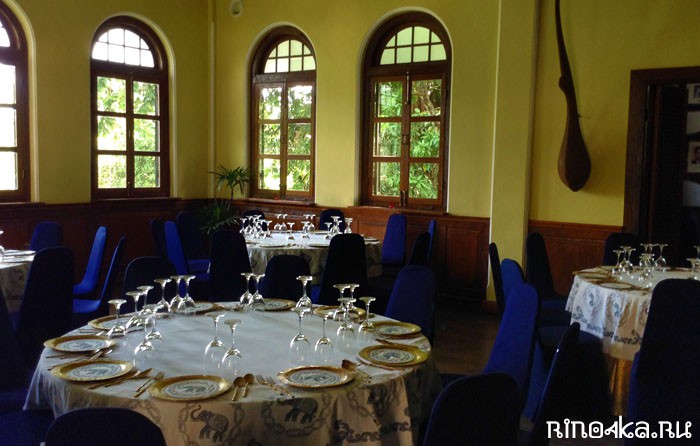
Роскошный двухэтажный особняк утопает в зелени вековых деревьев. Лужайка перед зданием используется для свадебных торжеств и других мероприятий с большим количеством гостей. Украшенные цветами столы с белыми скатертями выставляют прямо в парке. Интерьер ресторана воссоздаёт изысканную атмосферу эпохи оловянного бума на Пхукете. Традиционные шахматные полы из плитки начала прошлого века, широкие арки на террасе, лестницы из тикового дерева и мебель под старину переносят нас в прошлое.
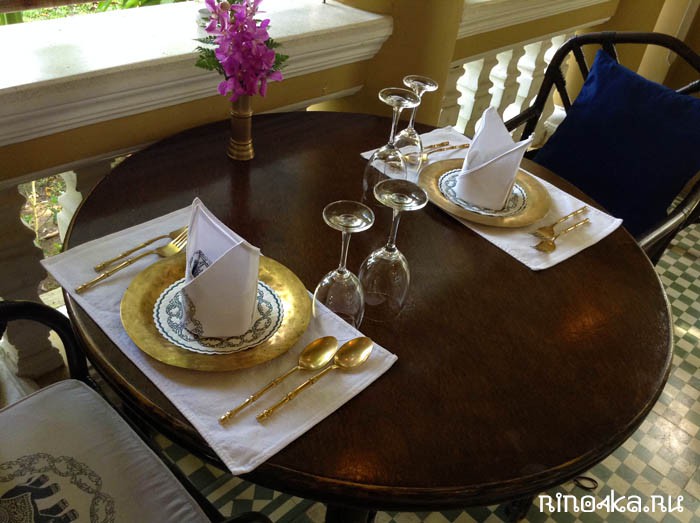
Барная стойка, выполненная в стиле модерн с голубой подсветкой, удачно контрастирует своим дизайном со всем рестораном-музеем. Вы можете расположиться внутри особняка, в помещении с кондиционером, или отдать предпочтение местам на открытой террасе. Особого дресс-кода здесь не предусмотрено, лучше, конечно, выбрать вечернюю одежду, избегая купальников и чересчур откровенных нарядов.
Шеф-повар Нурор настоящий профессионал по части королевской тайской кухни. Она с детства увлекалась приготовлением еды и с любовью собирала забытые рецепты традиционных блюд. Все свои навыки и умения Нурор выразила в меню ресторана. Здесь предлагают аутентичные блюда королевской и традиционной тайской кухни. Большинство ингредиентов органические и выращены на ферме Royal Project в экологически чистых условиях.
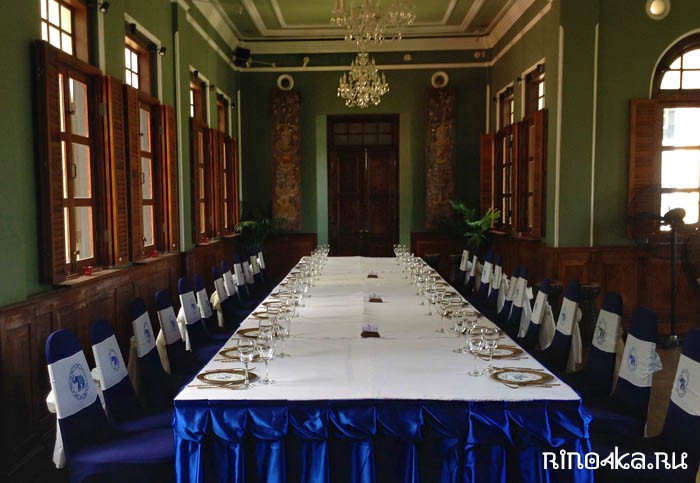
В меню есть два варианта для заказа. Вы можете выбрать сет, в который включены закуски, горячее и десерт. Наборы блюд варьируются в зависимости от дня недели и стоят 590++ бат для одного человека. Либо у вас есть возможность сделать заказ a la carte. Средний счёт на человека будет от 800 бат.
Из закусок закажите нежное суфле краба в карри, фуагра с тамариндовым соусом, салат из ананасов с креветками или острый ям-вунсен с лапшой и дарами моря. Из супом можете отдать предпочтение классическим тайским блюдам или попробовать том ям по рецепту периода Рамы V. На горячее возьмите маринованную утиную грудку с тамариндовым соусом или морского окуня на пару с лимонным сорго и лаймом. А может быть вы выберите массаман с ягнёнком по традиционному рецепту, описанному в поэме Рамой II.
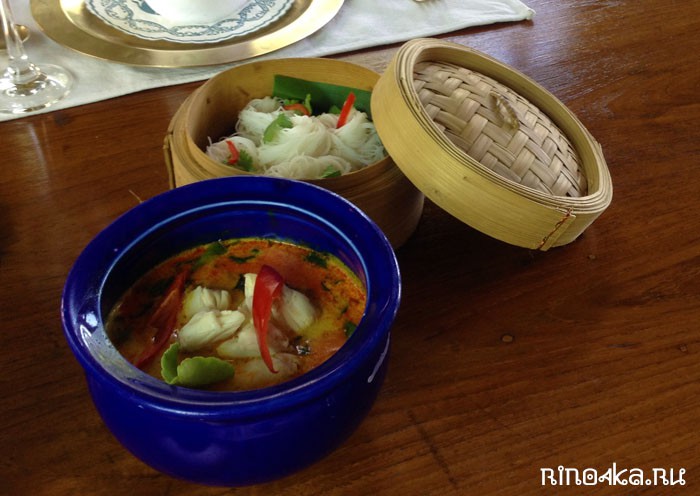
Что же взять на десерт? Мне нравится крем-брюле с имбирём, десерт подают в половинке кокоса. Если вы уже оценили короля тайских фруктов, попробуйте чизкейк с дурианом. Или закажите тайскую классику — манго с клейким рисом в кокосовом молоке.
Для желающих постичь все секреты приготовления тайской кухни открыты кулинарные курсы. Можно выбрать мастер-класс на половину дня, так и на несколько дней. Вы узнаете, как выбирать свежие фрукты и овощи на тайском рынке, познакомитесь с разнообразными хитростями поваров и научитесь готовить классические блюда Таиланда.
При ресторане открыт магазин с сувенирами и продукцией Blue Elephant: соусами, пастой карри, наборами для приготовления супов и основных блюд. А также вы можете найти товары Blue Elephant супермаркете торгового центра Central Festival или в аэропорту Пхукета.
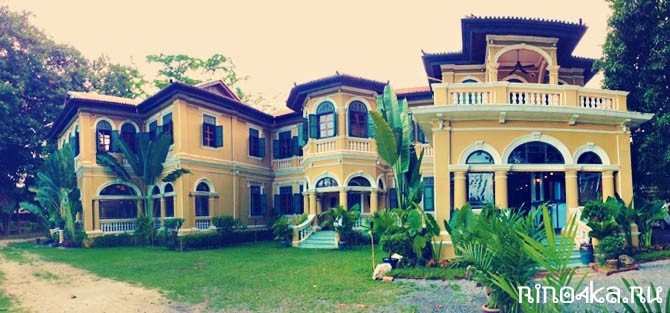
Ресторан Blue Elephant
Адрес: 96 Krabi Road, Tambon Talad Neua, Muang District, Phuket
Координаты: 7.886089, 98.384614
Ресторан открыт с 14:30 до 22:00. Заказ сет-меню возможен с самого открытия, блюда а-ля карт подают с 18:30.
Источник
Elephant Apple amazing facts
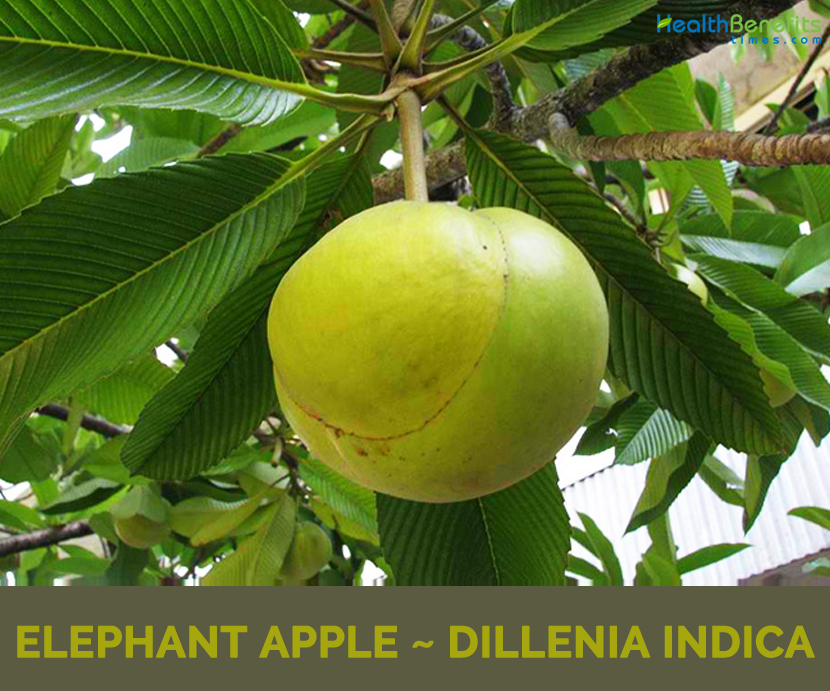
| Elephant Apple Quick Facts | |
|---|---|
| Name: | Elephant Apple |
| Scientific Name: | Dillenia indica |
| Origin | North Eastern part of India |
| Colors | Greenish- yellow |
| Shapes | Large, knobbly, sub globose up to 12 cm diameter, consisting of aggregate of 15–20 carpels |
| Taste | Bitter Sour |
| Health benefits | Cure stomach related problems, Protects Kidney , Improved RBC Count, Constant Energy Levels, Delayed Aging, Fights Infections, Good for Eye Health, Lower Blood Pressure |
Plant Description
Elephant apple is an evergreen large shrub or small to medium size tree growing to 15 m tall. The plant is found growing in evergreen forest or tropical rain forest, often along rivers and normally prefers well-drained sandy loam. It also grows best in a rich, slightly acid soil. Trunk is straight with 6 feet in girth, with a dense rounded crown, straight but not high. Barks are reddish brown in color and exfoliating. Young branchlets is brown pubescent, glabrescent and contains leaf scars. Its branches are used to make good firewood.
Leaves
Leaves are found growing crowded together at the ends of the branches and are oblong-lanceolate, acuminate. They are 20-30 long and 10 cm wide and have sharply serrate, the nerves close, running into the serratures. The upper surface and the nerves beneath are more or less pubescent.
Flower
Flowers are single; 12–20 cm in diameter, bud is more than 5 cm in diameter. Sepals are 5 in number, nearly rounded, orbicular, concave, 4–6 cm in diameter, thickly and fleshy. Petals are 7-9 cm in size, white and obovate. Stamens are found in 2 distinct groups, outer very numerous, somewhat curved in bud, inner ca. 25, apically reflexed outward in bud; anthers are dehiscing with 2 pores. Carpels are 16–20 in number. Numerous ovules are found per carpel. Flowering normally occurs from May-June.
Fruit
Fruit is large, knobbly, greenish- yellow and sub globose up to 12 cm diameter, consisting of collective of 15–20 carpels, each carpel consists of 1–8 small, brown hairy fringed, exarillate, endospermic, compressed, reniform seeds surrounded in an edible, glutinous pulp and is made up of the large fleshy imbricate sepals which strongly enclose the true fruit. Fruit pulp is bitter-sour and are used in Indian cuisine for making curries, jam and jellies. It is habitually mixed with coconut and spices to make chutneys. It is far used in Dal and in fish preparations in Assam.
History
Elephant Apple is native to the East Indies – from India, Sri Lanka east to southwestern China (Yunnan) and Vietnam and south through Thailand to Malaysia and Indonesia.
Chemical constituents
The plant Dillenia indica L. consists of number of classes of compounds such as phenols, tannins, alkaloids, flavonoids, saponins, sugars etc. The bark, fruit, leaf and stem of D.indica L. contains betulinaldehyde, betulinic acid, lupeol and dillenetin. The fruit and stem contains myricetin and isorhamnetin. The bark and sepal contains betulin. Stigmasterol is found in the leaves and stem while β-sitosterol is found in the bark, fruit and leaves. The fruit also contains cycloartenone and n-hentriacontanol. A total of eleven compounds were reported but there is still lack of knowledge on details of chemical constituents present in different parts of D.indica L.
Health benefits of Elephant Apple
Elephant apples are loaded with a variety of health-giving nutrients Regardless if you eat them in the form of jam or as part of a dish, you will certainly get an amazing number of perks. Here are few of those bonuses that elephant apples are known to offer:
1. Lower Blood Pressure
In case you are tired of eating bananas just to keep your blood pressure in normal range due to its potassium content, Elephant apple is one of the best alternatives. With these exotic treats, it can be easier to keep high blood pressure at bay.
2. Good for Eye Health
Elephant apples are good sources of vitamin A, nutrient known to keep the eyes healthy. Eye experts say that there are a number of eye issues that can actually lead to vision loss, and, most of them can be cured by outstanding diet that’s rich in vitamin A. Regular used of Elephant apple is considered quite beneficial for taking good care of your eyes.
3. Fights Infections
Elephant apples consist of good amount of vitamin C. We all know that vitamin C is very important for maintaining a strong immune system. If you are susceptible to have flu, cold or any other type of infection, then frequent use of vitamin C-rich fruits like elephant apples can work to your utmost advantage. Use it frequently.
4. Delayed Aging
Vitamin C is also extremely beneficial for people who want to look young. It is the fact that Vitamin C is essential for the synthesis of collagen, which is a type of protein that helps to make skin firm so that it can become less vulnerable to wrinkling. Furthermore, vitamin C is an antioxidant that fights off free radicals that quicken skin aging.
5. Constant Energy Levels
Elephant apples contain abundant amounts of B vitamins. If you feel weak quite easily, then consuming these fruits can help you in making you more energetic. Similarly, B vitamins are not only energy generators. They are also significant for keeping your brain and nerve cells in an excellent condition.
6. Improved RBC Count
Iron can also be found abundantly in Elephant apples. Thus it is recommended to consume elephant apple on a regular basis by those who are suffering from iron-deficiency anemia. Regular use of Elephant apples can also help in flushing out impurities and toxic substances in the bloodstream.
7. Protects Kidney
Elephant Apple is remarkably exclusive in stimulant and safe framework. This organic product helps to secure the kidneys reliably. Antiquated Indian researchers make use of elephant apple as the best typical medicine to expel kidney issues. It is likewise lucrative for liver and heart.
8. Cure stomach related problems
As we all know that tannin-containing substances are quite beneficial for endless loose bowels and stomach torment. Elephant Apple blends the bark of the tree along with nectar and plays an important role for such stomach issues. This natural product extracts fills in as a preventive prescription for cholera and many more.
Traditional uses and benefits of Elephant Apple
- Elephant apple is broadly used because of its medicinal values. Its barks and leaves are used as a laxative and astringent. Fruit juice is also used as a cough mixture and a cooling beverage for toning up the nervous system.
- In Ayurveda Elephant apple is considered as a ‘vat’ suppressant, ‘pitta’ supplementing drug.
- Fruit juice when mixed with sugar and water can be used as a cooling beverage for fevers and cough mixture.
- Leaf, fruit and bark of the plant are used in the indigenous system of medicine.
- It helps to relieves abdominal pain and controls the heat in the body.
- Fruit also helps to tone up the nervous system and take out fatigue.
- Fruit juice is commonly used as a cardio tonic.
- Bruised bark can also be used as a cataplasm for patients with arthritis.
- Alcoholic extract of the Elephant apple leaves is considered to have central nervous system (CNS) depressant activity.
- Plant is aphrodisiac and normally promotes virility.
- Fruit is sweet, acidic, astringent, removes bile, phlegm, fetid and flatulence.
- Green fruit is acidic, pungent, hot, removes wind, phlegm, but the ripe fruit is sweet, sour, appetizing and beneficial in colic associated with mucous.
- Decoction of the plant can also be used as widespread antidote for poison.
- Juice from fruit can also be consumed as a treatment of heart related diseases.
- In the tribal areas of Mizoram, juices from leaves bark and fruits are combined and given orally for the treatment of cancer and diarrhea.
- Fruit is kept beneath the bed for prevention of small pox and cholera in Assam.
- Assamese people use the fruit as natural pesticide during paddy farming.
- Bodas people use the fruit to cure stomach related disorders.
- Fruits are used for curing hair fall and dandruff by Manipuri people.
- Rajbongshis applied mucilage on wounds and burns.
- Fruits are consumed to combat weakness by Mikir people.
- A decoction of fruit is used as anti-dandruff and applied on head to check frequent hair fall. Fruit is also eaten to combat weakness.
- Decoction of fruit is used to remove dandruff.
- Small piece of leaf is consumed in the treatment of dysentery.
- Root is used as prophylactic for cholera.
- Roots are also one of the main ingredients of a paste used in the treatment of burning sensation in the chest.
- Its bark is used therapeutically to treat the infection of the mouth.
Culinary Uses
- Fleshy sepals enclosing the fruit are also eaten.
- Fruits are sour in taste and are normally used to flavor food.
- Fruit pulp is used in jellies, jams, curries (particularly prawn curries) and drinks.
- Sepals of the flowers are used for preparing Syrup.
- Unripe fruits are cooked for making chutney and pickle in Thailand.
- Young fruits are sliced and added to sweet and sour soup called kang som.
- Juicy pulp is quite aromatic but is very acidic.
- Sour fruit are consumed by individuals living in the mountains of southern Yunnan and adjacent Guangxi.
- Unripe fruits are used to make curries due to its sour taste and ripe fruits are used for making pickles in most parts of Assam.
Источник



